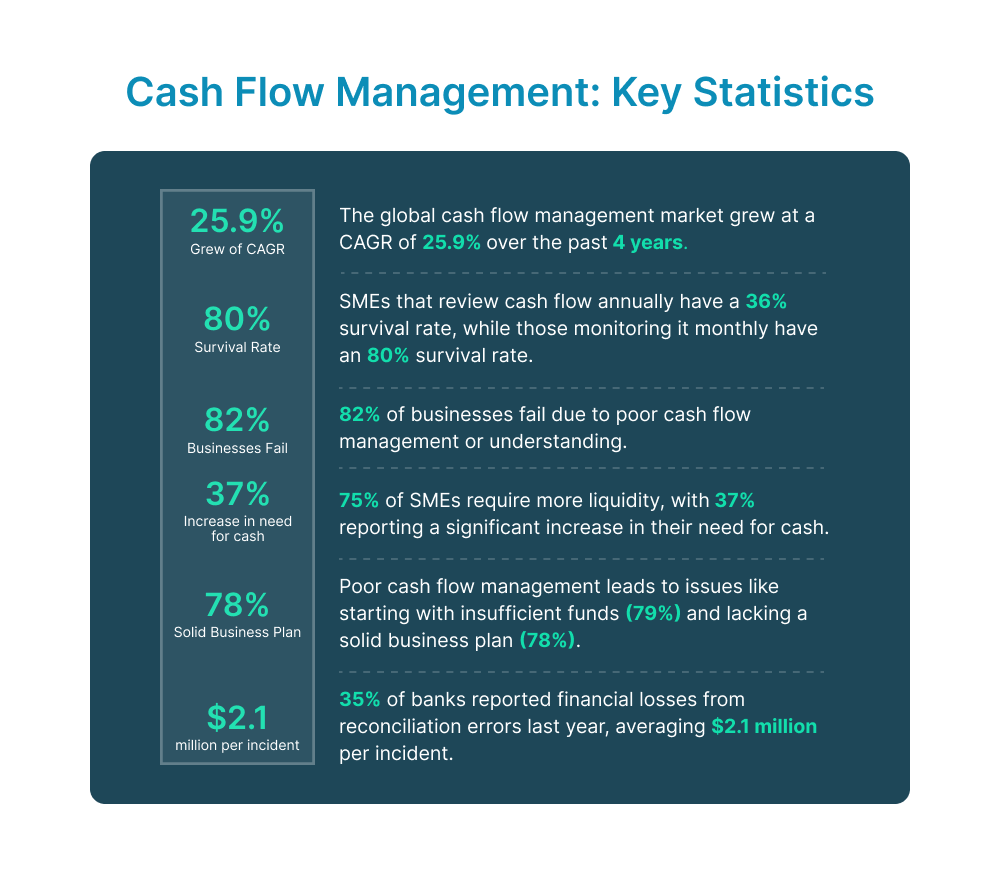Cash Reconciliation
Cash Flow Reimagined: Why AP Automation is the CFO’s Next Strategic Move
Explore how AP automation transforms cash flow management, making it a strategic move for CFOs by streamlining processes and enhancing cash reconciliation.

Amrit Mohanty
Dec 3, 2024 (Last Updated: Nov 14, 2025)

In a recent interview with PYMNTS, Steve Tackett, EVP of Operations at Priority, pointed toward an enormous change. He emphasized that "Automating accounts payable isn't just about tech getting better—it's really a game-changer in the way cash flow can be more effectively managed." And, this change is occurring at quite a pivotal time because the global cash flow management market is expected to leapfrog from $0.4 billion in 2020 to $1.2 billion by 2025, with a Compound Annual Growth Rate (CAGR) of 25.9% in this period.
Managing cash flow has always been of prime importance to the CFOs, but reaching there is a real hassle, particularly with issues/challenges such as late payments, tedious manual work, and old-school tools. But if we take a moment to think about it, it's pretty obvious that almost everything has a resolution. The trick lies in the delivery time as well as the pliability. Let’s understand in detail how AP automation enhances cash reconciliation, streamlines processes, and transforms cash flow management into a strategic tool for CFOs.
Why AP Automation Is the New Frontier
One of the biggest challenges CFOs have long grappled with is the inefficiency of accounts payable (AP) processes, particularly when it comes to cash reconciliation. Manual processes such as invoice approvals, payment verifications, and the reliance on paper checks create bottlenecks that ripple across financial operations. Tackett’s analogy of paper checks as the 'cockroach of B2B payments' is striking—not because they’re indestructible, but because they persist stubbornly despite their glaring inefficiency. This reliance on outdated methods not only delays payments but also complicates cash flow visibility and makes reconciliation a labor-intensive, error-prone task.
Embracing automation, as Tackett suggests, transforms AP processes by integrating all payment methods such as cards, ACH, wire transfers, and paper checks—into a single platform. This simplifies reconciliation, reduces errors, and provides real-time cash flow visibility. Tackett’s 'three Cs' i.e. completeness, configurability, and curation are here to guide CFOs in modernizing AP systems. Complete integration reduces the need for multiple systems, configurability customizes workflows, and curation ensures a consistent experience for suppliers.
The 'Three Cs' of AP Automation
1. Completeness: A truly integrated accounts payable automation platform consolidates various payment methods, which significantly enhances operational efficiency.
- Time Savings: According to a survey by the Institute of Financial Operations & Leadership, 56% of AP teams spend over 10 hours per week on manual invoice processing alone, indicating substantial time that could be saved through automation.
- Error Reduction: Implementing integrated AP automation tools can reduce data entry errors by up to 80%, which is crucial for minimizing costs associated with inaccuracies and discrepancies.
2. Configurability: AP automation's configurability enables businesses to customize workflows to meet their specific needs.
- Automation Adoption: A 2023 survey found that only 17.7% of businesses have fully automated their AP processes, while 62.5% have partially automated, indicating a significant opportunity for customization and improvement in workflow design.
- Cost Barriers: The primary barrier to automation reported was the cost of software, highlighting the need for configurable solutions that align with different budgetary constraints and operational requirements.
3. Curation: By curating payment processes, businesses can foster stronger supplier relationships and improve the overall experience.
- Supplier Relationship Management (SRM) Impact: Companies that focus on building strong supplier relationships can see up to a 30% increase in stability during crises. This statistic highlights how effective curation and management of supplier interactions contribute to resilience and reliability in supply chains
- Performance Improvement: By setting clear expectations and engaging in regular feedback, businesses can boost supplier performance by over 20%. This improvement stems from better collaboration and communication, which are essential components of a curated payment process.

Turning the Back Office Into a Strategic Asset
Historically, AP has been a cost center, but Tackett makes a bold argument: it can become a profit center. Virtual cards are a prime example. They not only expedite payments but also offer tangible financial benefits, such as cash-back incentives and reduced fraud risks. For suppliers, the switch from checks to virtual cards means faster access to funds and fewer logistical headaches.
Additionally, AP automation unlocks strategic opportunities for working capital management. Leveraging credit terms on corporate cards can free up capital for investments while optimizing cash flow. The customization capabilities introduced by networks such as Visa and Mastercard further empower businesses to tailor solutions to their financial strategies.
The Role of AI in AP’s Future
Artificial Intelligence (AI) is significantly transforming Accounts Payable processes, enhancing efficiency and providing strategic insights for CFOs. By leveraging AI-powered systems, organizations can analyze large datasets to develop tailored payment strategies that optimize cash flow and strengthen supplier relationships.
Enhanced Efficiency and Cost Savings
AI integration in AP has proven to reduce manual labor and improve processing times dramatically. For instance, AI algorithms have been reported to reduce invoice approval times by 40% as of February 2024. Additionally, companies utilizing AI for real-time analytics have experienced a 15% improvement in cash flow management by tracking payments and outstanding invoices more effectively. Moreover, the automation of routine tasks through AI can lead to a 76% reduction in payment processing costs, allowing finance teams to reallocate resources to more strategic initiatives. This is crucial as about 60% of fraud cases in B2B transactions involve paper checks, which AI can help eliminate.
Predictive Capabilities
AI's predictive analytics capabilities are reshaping how businesses manage cash flow. By analyzing historical data and transaction patterns, AI can forecast outgoing payments with greater accuracy, helping organizations avoid financial bottlenecks. For example, firms that implemented AI-driven predictive analytics reported a 25% improvement in budgeting accuracy starting from early 2023.
AI also enables companies to negotiate early payment discounts effectively. A mid-sized tech company utilizing automated AP processes achieved a 10% reduction in total payable amounts through such negotiations. This not only improves cash flow but also enhances working capital management.
Strategic Insights for CFOs
The strategic value of AI in AP extends beyond mere automation. A PYMNTS report indicates that 78% of CFOs view AI integration as crucial for enhancing AP processes, with 85% believing it leads to more accurate and efficient operations. By providing real-time insights into spending patterns and cash flow trends, AI empowers CFOs to make informed decisions that drive profitability and growth.
In essence, the adoption of AI in Accounts Payable is not merely about automating tasks; it is about transforming AP into a proactive, strategic asset that aligns with business objectives. As companies increasingly embrace these technologies, they position themselves for a future of seamless financial operations that adapt to their evolving needs.
Breaking the Resistance to Change
The journey to AP automation often faces resistance as organizations worry about losing control over cash flow. These concerns stem from a legacy mindset that links manual processes to better oversight. But today’s advanced technologies offer solutions like algorithm-driven oversight, allowing CFOs to maintain control and visibility without the inefficiencies of manual work.
For businesses still using paper-based processes, the risks go beyond delays—paper checks create bottlenecks, fraud, and errors that disrupt cash flow. While it’s tempting to stick with the familiar, those who don't embrace integrated payables platforms and virtual payments risk falling behind competitors. These modern tools streamline operations, improve cash flow visibility, reduce fraud, and help manage working capital more effectively.
Ultimately, automation shifts businesses from reactive cash flow management to a proactive, strategic approach, empowering growth with tailored AP systems that meet unique needs.
Closing Thoughts
AP automation is more than an operational upgrade; it's a strategic pivot. Tackett’s insights serve as a clarion call for CFOs to rethink their approach to cash flow management. By leveraging tools such as virtual cards, integrated platforms, and AI-driven strategies, businesses can not only solve today’s pain points but also build resilience for the future.
The question isn’t whether AP automation is worth it; it’s how long businesses can afford to wait before making the leap. In a landscape where cash flow defines success, the answer seems clear.

